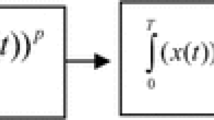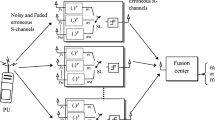Abstract
This paper presents, optimization analysis of energy detection based cooperative spectrum sensing system (CSSS) with hard-decision combining. Several system parameters are optimized to evaluate an optimal performance theoretically over noisy and generalized fading channels. In particular, wireless environments with noise plus \(\kappa -\mu \) and \(\eta -\mu \) fading are considered in the sensing channels. More precisely, each secondary user (SU, also called as cognitive radio user) depend on an energy detector (ED). The SU collects the signal from the primary user (PU), is given as input to the ED, and the energy of the signal is calculated for making a binary decision locally. The locally obtained decisions are combined using hard-decision combining and a final decision about position of the PU is made. In this work, the novel mathematical expressions for detection probability of a single SU is derived first, subject to noise plus fading and validated by using Monte Carlo simulations. Next, we develop theoretical frame works for optimization analysis of CSSS using derived mathematical expressions. The channel error probability is considered in both sensing and reporting channels. Further, we derive closed-form optimal expressions of number of SUs and detection threshold subject to generalized fading and optimal values are calculated. Through receiver operating characteristics (ROC), complementary ROC and total error rate, system performance is evaluated for the significant influence of channel and network parameters. Finally, the influence of the generalized fading severity parameters, the signal-to-noise ratio (SNR), the number of SUs, the detection threshold, and the channel error probability on the performance of CSSS is also investigated.











Similar content being viewed by others
References
Mitola, J., & Maguire, G. Q. (1999). Cognitive radio: making software radios more personal. IEEE Personal Communications, 6(4), 13–18.
Biglieri, E. (2012). An overview of cognitive radio for satellite communications. In Proceedings of IEEE first AESS European conference on satellite telecommunications (ESTEL) (pp. 1–3). Rome, Italy.
Digham, F. F., Alouini, M.-S., & Simon, M. K. (2007). On the energy detection of unknown signals over fading channels. IEEE Transactions on Communications, 55(1), 21–24.
Ghasemi, A., & Sousa, E. S. (2007). Opportunistic spectrum access in fading channels through collaborative sensing? IEEE Transactions on Wireless Communications, 2(2), 71–82.
Balam, S. K., Siddaiah, P., & Nallagonda, S. (2019). Performance analysis of decision/data fusion-aided cooperative cognitive radio network over generalized fading channel. IEEE Transactions on Aero Space and Electronics Systems (IEEE TAES), 55(5), 2269–2276.
Akyildiz, I. F., Lo, B. F., & Balakrishnan, R. (2011). Cooperative spectrum sensing in cognitive radio networks: a survey. Physical Communication, 4(1), 40–62.
Chaudhari, S., Lundn, J., Koivunen, V., & Vincent Poor, H. (2012). Cooperative sensing with imperfect reporting channels: hard decisions or soft decisions? IEEE Transactions on Sgnal Processing, 60(1), 18–28.
Nallagonda, S., Chandra, A., Roy, S. D., Kundu, S., Kukolev, P., & Prokes, A. (2016). Detection performance of cooperative spectrum sensing with hard decision fusion in fading channels. International Journal of Electronics , 103(2), 297–321.
Zhang, W., Mallik, R., & Letaief, K. B. (2009). Optimization of cooperative spectrum sensing with energy detection in cognitive radio networks. IEEE Transactions on Wireless Communications., 8(12), 5761–5766.
Banavathu, N. R., & Khan, M. Z. A. (2017). Optimal number of cognitive users in \(K\)-out-of-\(N\) rule. IEEE Wireless Communications Letters., 6(5), 606–609.
Banavathu, N. R., & Khan, M. Z. A. (2019). Optimization of \(N\)-out-of-\(K\) Rule for Heterogeneous Cognitive Radio Networks. IEEE Signal Processing Letters., 26(3), 445–449.
Banavathu, N. R., & Khan, M. Z. A. (2016). On the throughput maximization of cognitive radio using cooperative spectrum sensing over erroneous control channel. In Proceedings of IEEE national conference on communication (NCC) (pp. 1–6). IIT Guwahati, India.
Ranjeeth, M., Anuradha, S., & Nallagonda, S. (2020). Optimized cooperative spectrum sensing network analysis in nonfading and fading environments. International Journal of communication Systems., 33(5), 42–62.
Moraes, A. C., Da Costa, D. B., & Yacoub, M. D. (2012). An outage analysis of multibranch diversity receivers with cochannel interference in \(\alpha -\mu \), \(\kappa -\mu \), and \(\eta -\mu \) fading scenarios. Wireless Personal Communications, 64(1), 3–19.
Yacoub, M. D. (2007). The \(\kappa -\mu \) distribution and \(\eta -\mu \) distribution. IEEE Antennas and Propagation Magazine, 49(1), 68–81.
Sofotasios, P. C., Rebeiz, E., Zhang, L., Tsiftsis, T. A., Cabric, D., & Freear, S. (2013). Energy detection based spectrum sensing over \(\kappa -\mu \) and \(\kappa -\mu \) extreme fading channels. IEEE Transactions on Vehicular Technology, 62(3), 1031–1040.
Adebola, E., & Annamalai, A. (2014). Unified analysis of eneregy detectors with diversity reception in generalized fading channels. IET Communications, 8(17), 3095–3104.
Gurugopinath, S. (2015). Energy-based bayesian spectrum sensing over \(\kappa -\mu \) and \(\kappa -\mu \) extreme fading channels. In Proceedings of IEEE national conference on communication (NCC) (pp. 1–6). Mumbai, India.
Gurugopinath, S. (2015). Energy-based bayesian spectrum sensing over \(\eta -\mu \) fading channels. In Proceedings of IEEE international conference on electronics, computing and communication technologies (CONECCT) (pp. 1–6) Bangalore, India.
Shobitha, S., & Gurugopinath, S. (2016). Energy-based bayesian spectrum sensing over \(\alpha -\eta -\mu \) fading channels. In Proceedings of IEEE India Conference (INDICON) (pp. 1–6). Bangalore, India.
Shobitha, S., & Gurugopinath, S. (2017). Energy-based bayesian spectrum sensing over \(\alpha -\kappa -\mu \) fading channels. In Proceedings of IEEE international conference on communication systems and networks (COMSNETS) (pp. 95–100). Bangalore, India.
Nuttall, A. H. (1975). Some integrals involving the \(Q_M\) function. IEEE Transactions on Information Theory, 21(1), 95–96.
Gradshteyn, I. S., & Ryzhik, I. M. (2007). Table of Integrals, Series and Products (7th ed.). San Diego, CA, USA: Academic Press/ Elsevier.
Ermolova, N. Y., & Tirkkonen, O. (2012). Outage probability over composite \(\eta \)-\(\mu \) fading-shadowing radio channels. IEEE Communcations Letters, 6(13), 1898–1902.
Nallagonda, S., Chandra, A., Roy, S. D., & Kundu, S. (2017). Analytical performance of soft data fusion-aided spectrum sensing in hybrid terrestrial-satellite networks. International Journal of Satellite Communications and Networking, 35(5), 461–480.
Author information
Authors and Affiliations
Corresponding author
Additional information
Publisher's Note
Springer Nature remains neutral with regard to jurisdictional claims in published maps and institutional affiliations.
Rights and permissions
About this article
Cite this article
Balam, S.K., Siddaiah, P. & Nallagonda, S. Optimization Analysis of Cooperative Spectrum Sensing System over Generalized \(\kappa -\mu \) and \(\eta -\mu \) Fading Channels. Wireless Pers Commun 116, 3081–3100 (2021). https://doi.org/10.1007/s11277-020-07836-8
Accepted:
Published:
Issue Date:
DOI: https://doi.org/10.1007/s11277-020-07836-8




